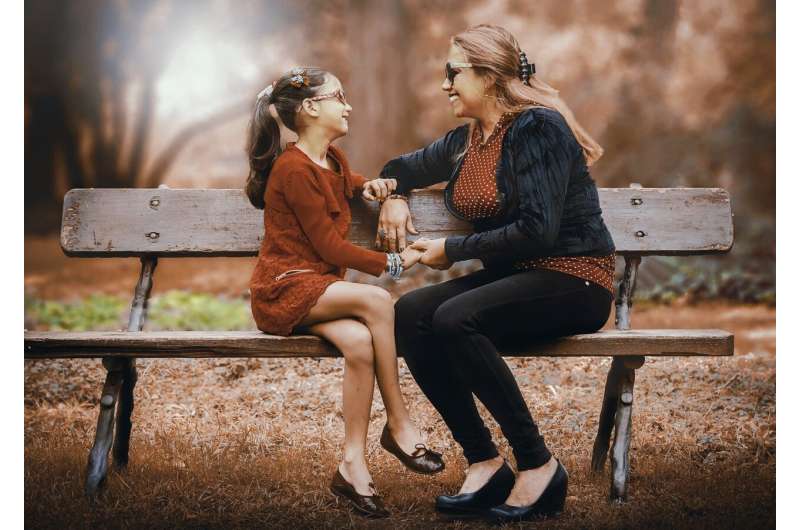This article has been reviewed according to Science X's editorial process and policies. Editors have highlighted the following attributes while ensuring the content's credibility:
fact-checked
peer-reviewed publication
trusted source
proofread
When mothers and children talk about problems, research says environment matters

Talking to their parents about daily stressors can help adolescents deal with their problems. This is particularly important during the transition to middle school, when youth often are faced with new peer and academic challenges.
But does it matter where these conversations take place? That's the topic of a new study from the University of Illinois Urbana-Champaign. The findings are published in The Journal of Early Adolescence.
"We were interested in the environmental settings for mother-youth conversations. Where do they typically happen, and what are the preferred locations? We wanted to get the perspectives of both the youth and their mothers," said co-author Kelly Tu, associate professor in the Department of Human Development and Family Studies (HDFS), part of the College of Agricultural, Consumer and Environmental Sciences (ACES) at Illinois.
The study included a racially diverse community sample of 100 fifth-grade students and their mothers. The pairs were first asked to discuss recent peer and academic problems the child had experienced, then they were interviewed separately about their preferred environments for talking about these issues. The researchers focused on mother-child dyads because mothers often are the primary caregiver who spends more time with youth and tend to be more involved with day-to-day activities.
Youth and mothers identified seven preferred locations for their conversations, including the house in general, youth's bedroom, kitchen, living room, parent's bedroom, car, and outdoor leisure spaces.
"The youth most frequently mentioned the house in general, followed by their bedroom, the kitchen, and the living room. They felt the home was a safe space and being in a comfortable environment encouraged conversation," Tu said. "Their bedroom was the preferred location if they needed privacy, whereas if they wanted input from more family members, they preferred the kitchen or living room."
For mothers, the top three locations included the kitchen, youth's bedroom, and the car.
"Mothers often preferred to talk in the car because they could engage in side-to-side conversations with their child, which they felt made the conversation easier and less intimidating compared to directly looking at one another.
"In the interviews, they would say, 'Where we talk about this the most is in the car, when I'm doing pickup or taking them somewhere because it gives us time and space away from others.' However, the car was not a preferred setting for the kids—perhaps they felt like they didn't have as much control in the conversation because it was a parent-dominated space," Tu noted.
Boys in particular mentioned outdoor leisure spaces, such as playing ball in the backyard or walking the dog. Family size also mattered in the responses. Only children were more likely to prefer the living room, perhaps because they were less likely to need the privacy of their bedroom. On the other hand, children with multiple siblings may not have their own room, so the parents' bedroom may be better for private conversations.
"We also found that families preferred to talk together in spaces that were already part of their established family routines because they provided opportunities for kids to initiate conversation," said lead author Dina Izenstark, an associate professor at San José State University who conducted the research as a doctoral student in HDFS. Mealtime routines can provide opportunities for each family member to talk about their day, while bedtime routines provide a more intimate setting for one-on-one conversations that need more discretion.
"Moms were talking about how they had been doing these things for a long time; for example, asking children about their day when tucking their kid in at bedtime or while eating dinner together. These kids are still young, and it may change during their teenage years, but they have the foundation for these conversations to continue to take place," Izenstark stated.
The research sample consisted of predominantly higher-income families, and results may not be directly generalizable to other groups, the researchers noted. For example, if a parent is working a third shift, the home is small, or there are multiple siblings, the time and space for privacy to talk about daily stressors may look different.
"We have to tailor our advice and rethink what it looks like for families in various circumstances. Every family is going to have their own pattern of moving through the day and their own rituals and routines, but we know that environmental setting matters and it is important for families to select a place to talk that is preferred by both the child and the parent as a way to more meaningfully connect with one another," Izenstark said.
The paper, "An exploration of the environmental setting mothers and early adolescent youth prefer to have conversations about daily stressors," is published in the Journal of Early Adolescence.
More information: Dina Izenstark et al, An Exploration of the Environmental Setting Mothers and Early Adolescent Youth Prefer to Have Conversations About Daily Stressors, The Journal of Early Adolescence (2024). DOI: 10.1177/02724316241240111




















